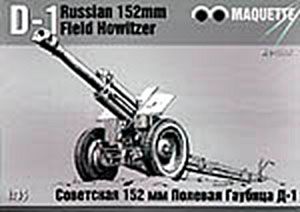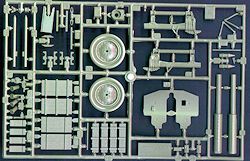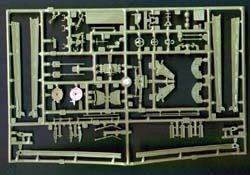
Maquette 1/35 D-1 152mm Howitzer
| KIT #: | MQ35034 |
| PRICE: | $ |
| DECALS: | None |
| REVIEWER: | Ray Mehlberger |
| NOTES: |

| HISTORY |
The D-1 howitzer M1943 is a Soviet WWII era 152.4 mm howitzer. The gun
was developed by the design bureau headed by F.F. Petrov in 1942 and 1943, based
on the carriage of the 122 mm M1938 howitzer (M-30) and using the barrel of the
152 mm M1938 (M-10) howitzer. This new gun had multiple roles: anti-personnel,
and anti-fortification.
The powerful and mobile D-1, with its wide range of ammunition
significantly increased the firepower and breakthrough abilities of Red Army
tank and motor rifle formations. Several hundred D-1ís were manufactured before
the end of WWII.
The D-1 had two-part ammunition: the war-head and the powder charge. It
could fire the type 530 high explosive, the type 0-530A fragmentation, the F-533
and F-534 fougasse (anybody know what these were?), and the type G-530 concrete
coated shell.
Post WWII, the D-1 saw combat in numerous conflicts during the mid-to
late 20th century. The long operational history of the D-1 howitzers in national
armies of numerous countries is a testimony to its qualities. The gun still
remains in service in a number of post Soviet States and some other coutries.
The D-1 is widely considered a valuable element of Soviet artillery.
Specifications:
Type: Field Howitzer
Origin: Soviet Union
In Service: 1943 to present
Used By: Countries of the former Warsaw Pact and Soviet Union
Wars: WWII, Arab-Israeli Wars, Vietnam War
Designer: F.F. Petrov
Designed: 1943
Manufactured: No. 9 plant
Number Built: 2,827
Variants: D-15 m1943/85
Weight: 7,936 lbs
Length: 22 ft.
Barrel Length: Bore: 10ft. 3in. Overall: 13ft. 10in.
Crew: 8
Shell: 88.2 lbs.
Caliber: 152.4 mm (6 in.)
Breech: Interupted screw.
Recoil: Hydroneumatic
Carraige: Split trail.
Elevation: Minus 3 degrees to 63.5 degrees.
Traverse: Plus or minus 17.5 degrees.
Rate of Fire: 3 Ė 4 rounds per minute.
Muzzle Velocity: 1,666 ft/min.
Maximum Range: 7.70 miles.
coil Length: 960 to 1070 mm
Firing Height: 1240 mm
Elevation Limits: -3 + 63 degrees 30'
Firing Sector: 35 degrees
Rate of Fire: 3 to 4 rounds per minute
I got this kit back in 2000 in trade with a modeler in Australia. He
sent it just in a cello bag with no box to hold the weight down for postage
needed. It is out of production and at the time of itís release was said to be a
limited run edition.
| THE KIT |
 There
are dark dark green trees of parts in the kit. Both of these trees have the
Zvezda brand name on them. So, it is obvious that this kit is a cooperative
effort between Maquette and Zvezda. Both brands are based in Russia.
There is also a small cello bag full of resin and white met
There
are dark dark green trees of parts in the kit. Both of these trees have the
Zvezda brand name on them. So, it is obvious that this kit is a cooperative
effort between Maquette and Zvezda. Both brands are based in Russia.
There is also a small cello bag full of resin and white met al
parts. So, the kit is also a multi-media one too.
al
parts. So, the kit is also a multi-media one too.
Tree letter 'A' of the plastic parts holds the gun trail arms (there are
some nasty sinks in these), shovels, and other assorted parts (57 parts here)
Tree letter 'B' of the plastic parts holds the wheels, gun shield, gun
barrel (this barrel is excess, as there is a resin one given for this kit),
barrel cradle, breech (again, a resin one is given for the kit),2 wood ammo
cases, and ammo etc. (57 parts here also) There are 4 ammo powder charges and 2
complete rounds here.
The sinks in the sides of the trail arms look like they will be a real
booger to fix. There is rivet detail etc. on either side of this groove that
runs almost the whole length of these parts.
A small bag of resin and white metal parts is included. These consist of
the gun barrel (two halves), breech, muzzle brake etc. seven resin and four
silver metal parts. The metal parts are for the breech block assembly. However
these white metal parts are not mentioned on the instruction sheet as being
metal ¨ but called out as being resin. Strange! Also one is not numbered and is
the closed door of the breech block.
There are no figures in the kit or any decals. I doubt the weapon ever
had any markings on it.
The instructions is a single 8" x 11" sheet, printed on both sides.
A short history is given in Russian and English. Six steps ¨ sometimes
rather confusing, are given for assembly. No mention is made of the 2 wood ammo
boxes and the ammo rounds or how to assemble them. Colors are called out in a
short sentence that says 'Over-all khaki green. Sometimes over-painted with
white wash in the winter. Camouflage rarely, if ever, used.
| CONCLUSIONS |
This kit looks fairly good, except for the sinks (mentioned earlier). A
gun crew and clearer instructions would have been nice.
Because of its obvious complexity and small parts and the dissimilar
materials used to mold the kit, I recommend this kit only to modelers that have
a few artillery models under their belts that are multi-media kits with resin
and metal parts in them.
The kit may appear some time on eBay perhaps.
September 2013
If you would like your product reviewed fairly and fairly quickly, please contact the editor or see other details in the Note to Contributors.